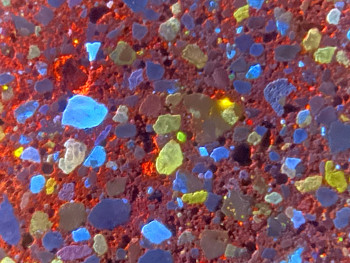Spotlight on: Cathodoluminescence Microscopy
Cathodoluminescence (CL) is the emission of visible light from a sample following excitation by an electron beam. Microtrace utilizes this characteristic property in the analysis of a wide variety of materials. These include rocks, soil, glass, and certain manufactured products such as building materials, paint, and tape. In these materials, variations in luminescence are directly related to trace elements and defects of the mineral component. These elements and defects help our scientists to understand the history of geological processes, processing history of that particular sample. In certain cases, this information can provide sourcing clues about the provenance of a sample.

Cathodoluminescence image of a concrete-based stucco in thin section.
Microtrace scientists have conducted some of the most extensive studies to date into forensic applications of CL. Dr. Palenik has authored a book chapter on the topic and presented numerous talks around the world on the subject. These have covered novel applications and techniques of cathodoluminescence microscopy in forensic science, such as trace evidence, forensic geology (including concrete), nuclear forensics, and materials sourcing.
A multitude of established techniques exist for the analysis of trace evidence. CL offers one widely-applicable alternative technique that provides a unique means for visualization and identification of trace elements and structural defects in a sample.
To learn more about Microtrace’s Cathodoluminescence Microscopy services visit our website, or contact us to discuss your questions or project.
References:
Palenik, C.S. and Buscaglia, J. (2007) Applications of cathodoluminescence in Forensic Science, in Forensic analysis on the Cutting Edge: new methods for trace evidence analysis, ed. R. Blackledge, Wiley.
Buscaglia, J., Palenik, C.S., Brokus, S.A., Silletti, D.K., Cooper, D.E., Purcell, D.K., Peaslee, G.F. (2011) Applications of Cathodoluminescence (CL) Microscopy and Spectroscopy to Forensic Evidence. Presented at Cathodoluminescence (CL 2011), a topical conference (TC) of the Microbeam Analysis Society (MAS), co-sponsored by the Australian Microbeam Analysis Society (AMAS) held at the National Institute of Standards and Technology (NIST), Gaithersburg, MD, USA on October 24-28, 2011.
Buscaglia, J., Palenik, C.S., and Peaslee, G. (2009) Trace evidence applications of cathodoluminescence (CL) microspectrophotometry. Trace Evidence Symposium (National Institute of Justice (NIJ), Clearwater Beach, FL.
Peaslee, GF, Buscaglia, J, Palenik, CS (2008) Cathodoluminescence as a Forensic Tool. 2008 Joint Meeting of The Geological Society of America, Soil Science Society of America, American Society of Agronomy, Crop Science Society of America, Gulf Coast Association of Geological Societies with the Gulf Coast Section of SEPM. Houston, TX.
Peaslee, GF, Palenik, CS, and Buscaglia, J (2008) Application of Cathodoluminescence Microspectrophotometry for Forensic Comparison of Concrete Samples. International Association of Forensic Sciences Conference Proceedings.
Palenik, CS (2006) Cathodoluminescence in Forensic Science. Presentation Soil Analysis workshop at California Association of Criminalists Fall Seminar.
Palenik, C.S. and Buscaglia, J. (2005) Cathodoluminescence microscopy in forensic science. 2006 Annual meeting of the American Academy of Forensic Sciences. Seattle, WA.
Palenik, C.S. and Buscaglia, J. (2005) Applications of cathodoluminescence in the forensic analysis of trace evidence. 2005 Annual meeting of SWGMAT (Scientific Working Group for Materials Analysis sponsored by the FBI), Washington, D.C.
Palenik, C.S. and Buscaglia, J. (2005) Applications of cathodoluminescence in forensic geology. 2005 Goldschmidt Conference, Moscow, Idaho, Geochmica et Cosmochimica Acta.
How May We Help You?
Contact usto discuss your project in more detail.








